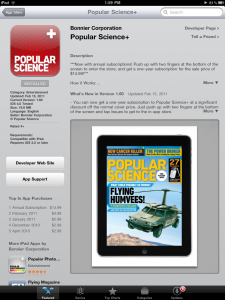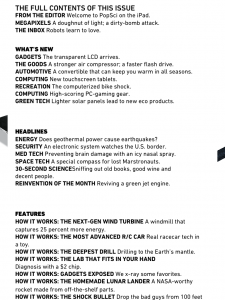One of the most promising features of the iPad was its potential to serve as a new kind of platform for magazines and newspapers. Previous e-readers had been hampered by their black-white-gray color configurations, but the iPad unleashed a wealth of color possibilities. Sure you can read the New York Times on a Kindle—but what’s the point if you can’t see the full color photos that bring the stories to life?
Until now, the iPad’s ability to replace physical magazines had been impeded by the absurd subscription costs (or rather, the lack of viable subscription options). It seemed fair to pay $4 for an issue of a magazine, but having to pay that 52 times in a year obviously diminishes the appeal.
Apple has now attempted to shift the playing field by offering subscriptions directly through the App Store. There has been much uproar over the fact that Apple is taking a 30% cut from publishing companies—whether that will affect us as consumers remains to be seen. Apple takes the same cut from movies, music, and e-books—all markets that have blossomed well and continue to grow under Apple’s aegis.
That being said, the ability to purchase directly makes things easier for iPad users. You simply purchase a one-year subscription in the same way that you would buy any other App. Click. Downloading begins. And you’re guaranteed a year of that magazine in elegant iPad form.
Perhaps the days of opening a magazine and being bombarded by subscription cards are now ancient history? Could those be the bells bringing us into a new age of digital reading? It’s difficult to predict how successful this venture will be. Its success depends on how many publishers jump on board and how many readers are willing to forsake print editions and shell out for something digital.
Currently, the App Store offers subscriptions to Elle, Nylon, and Popular Science (in addition to Rupert Murdoch’s clumsy leviathan, The Daily). The slim selection of offerings leaves something to be desired, but the prices are enticing and encouraging for the future (ranging from $9.99 to $18.99). Each publication provides a wealth of offerings with promised iPad-only features—videos, audio, behind-the-scenes specials, you name it.
Popular Science uses the iPad to its fullest by allowing a reader to enjoy a kinesthetic experience: you reach the table of contents by pushing up with two fingers at the bottom of the screen, tap the screen to make the text disappear so you can focus on images, swipe left and right in order to change articles, and swipe down in order to read the full article. You might need to keep a water bottle by your side in case this work leaves you out of breath.
Nylon does not necessarily offer all of the sophisticated bells and whistles that Popular Science does, but it does provide a similarly sleek reading experience.
Not only does the iPad medium allow a reader to access new information but also it allows the reader to experience that information in a stunning and novel way. We can only hope that other magazines will follow this course that is so kind and considerate to our wallets.



